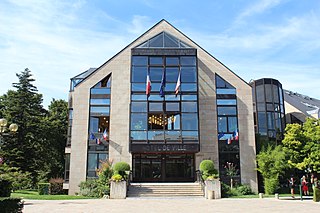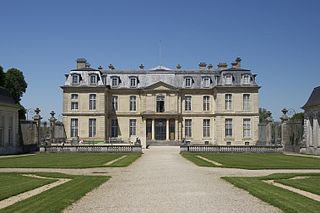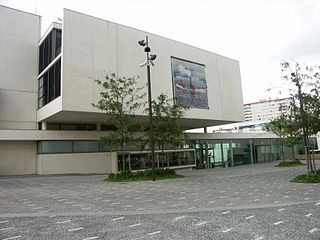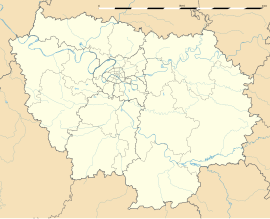
Val-de-Marne is a department of France located in the Île-de-France region. Named after the river Marne, it is situated in the Grand Paris metropolis to the southeast of the City of Paris. In 2019, Val-de-Marne had a population of 1,407,124.

Choisy-le-Roi is a commune in the Val-de-Marne department, in the southeastern suburbs of Paris, Île-de-France.

Créteil is a commune in the southeastern suburbs of Paris, Île-de-France. It is located 11.7 km (7.3 mi) from the centre of Paris. Créteil is the préfecture (capital) of the Val-de-Marne department as well as the seat of the Arrondissement of Créteil. The city is, moreover, the seat of a Roman Catholic diocese and of one of France's 30 nationwide académies (districts) of the Ministry of National Education.

Ivry-sur-Seine is a commune in the Val-de-Marne department in the southeastern suburbs of Paris, France. It is located 5.3 km from the centre of Paris.

Pontoise is a commune north of Paris, France. It is located 28.4 km (17.6 mi) from the centre of Paris, in the "new town" of Cergy-Pontoise.

Neuilly-sur-Marne is a French commune in the Seine-Saint-Denis department, Île-de-France. It is located 13.1 km (8.1 mi) from the center of Paris.

Ormesson-sur-Marne is a commune in the southeastern suburbs of Paris, France. It is located 16.1 km (10.0 mi) from the center of Paris.

Torcy is a commune in the Seine-et-Marne department, Île-de-France, north-central France. It is located in the eastern suburbs of Paris, 21.8 km (13.5 mi) from the center of Paris.

The arrondissement of Créteil is an arrondissement of France in the Val-de-Marne department in the Île-de-France region. It has 16 communes. Its population is 323,676 (2021), and its area is 99.8 km2 (38.5 sq mi).

Chessy is a commune in the eastern suburbs of Paris, in the Seine-et-Marne department in the Île-de-France region in north-central France. It is located 30.6 km (19.0 mi) from the center of Paris.

Champs-sur-Marne is a commune in the eastern outer suburbs of Paris, France. It is located 18.2 km (11.3 mi) from the centre of Paris, on the left bank of the Marne, in the Seine-et-Marne department in the Île-de-France region.

Le Perreux-sur-Marne is a commune in the Val-de-Marne department in the eastern suburbs of Paris, France. It is located 11.7 km (7.3 mi) from the center of Paris.

Chevilly-Larue is a commune in the southern suburbs of Paris, France. It is located 9.3 km (5.8 mi) from the center of Paris.

Lagny-sur-Marne is a commune in the eastern suburbs of Paris, France. It is located in the Seine-et-Marne department in Île-de-France 26.1 km (16.2 mi) from the centre of Paris.

Croissy-Beaubourg is a French commune located in the Seine-et-Marne département, in the Île-de-France région.

The Musée d'Art Contemporain du Val-de-Marne, nicknamed MAC/VAL, is a museum of contemporary art located in the Place de la Libération in Vitry-sur-Seine, Val-de-Marne, a suburb of Paris, France. It is open daily except Mondays; an admission fee is charged.
Melik Ohanian is a French contemporary artist of Armenian origin. He lives and works in Paris and New York City. His work has been shown in many solo exhibitions including Galerie Chantal Crousel, Centre Pompidou and Palais de Tokyo in Paris, South London Gallery in London, De Appel in Amsterdam, IAC in Villeurbanne, Yvon Lambert in New York, Museum in Progress in Vienna, and Matucana 100 in Santiago de Chile.

Jean Messagier was a French painter, sculptor, printmaker and poet. Jean Messagier had his first solo exhibition in Paris at Galerie Arc-en-Ciel in 1947. From 1945 to 1949 the artist worked under the influence of Pablo Picasso, André Masson, Paul Klee and François Desnoyer, his professor at École nationale supérieure des arts décoratifs in Paris. Messagier again was revealed to the public at an exhibition organized by Charles Estienne at the Galerie de Babylone in 1952, entitled "La Nouvelle École de Paris". The following year, Messagier deliberately broke away from his expressionistic form of Post-Cubism; his inspirations now focused on Jean Fautrier and Pierre Tal-Coat to develop a personal vision in which he renders "light...approached abstractly." Jean Messagier is often associated with Lyrical abstraction, Tachisme, Nuagisme, Art informel and paysagisme abstrait, though the artist himself had never accepted any labels, and had always refused the distinction between abstraction and figuration. From 1962 until the year of his death Jean Messagier exhibited in France and abroad, taking part in some major international events as a representative of new trends in French painting.
Delphine Coindet is a French installation artist.

Louis Cane was a French painter, sculptor, and furniture designer. He was a member of the Supports/Surfaces movement in France, which lasted from 1969 to 1972. Much of his work focused on the concept of deconstruction of the canvas.























